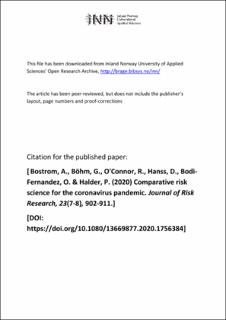Comparative risk science for the coronavirus pandemic
Peer reviewed, Journal article
Accepted version
Permanent lenke
https://hdl.handle.net/11250/3082453Utgivelsesdato
2020Metadata
Vis full innførselSamlinger
Sammendrag
Judgment, decision making, and risk researchers have learned a great deal over the years about how people prepare for and react to global risks. In recent years, risk scholars have increasingly focused their energies on climate change, and as pandemic coronavirus has swept the globe many of these scholars are comparing the coronavirus pandemic with climate change to inform risk management. Risk communication research and the best practices developed from it are predicated on findings from the 1970’s to the present showing that there are structural similarities in how people think about widely divergent risks. Consequently, these lessons from risk communication of climate change (and from the canon of best practices) apply to the coronavirus pandemic. In the empirical comparison of student perceptions reported here, we replicate these structural similarity findings, but also find that moral concerns in particular deserve attention as a potentially distinct dimension of risk perception, on which different risks may also differ, as pandemic risks appear to evoke less moral concern than climate change. The need for communications to be timely, honest, credible, empathetic, and informative for useful individual actions is fundamental and essential for communicating effectively about the coronavirus epidemic. Some countries have heeded risk sciences, and are coping more successfully with pandemic coronavirus. Others have failed to implement these old lessons, which our data suggest still apply. While these failures may reinforce cynicism about political and public enthusiasm for accepting science, comparisons between the coronavirus pandemic and climate change may also foster greater aspirations for collective action.
Beskrivelse
© 2020 Informa UK Limited, trading as Taylor & Francis Group. Dette er den aksepterte versjonen av en artikkel publisert i Journal of Risk Research. Du finner den publiserte artikkelen her: https://doi.org/10.1080/13669877.2020.1756384 / This is the postprint version of the article published in Journal of Risk Research. You can find the published article here. https://doi.org/10.1080/13669877.2020.1756384

